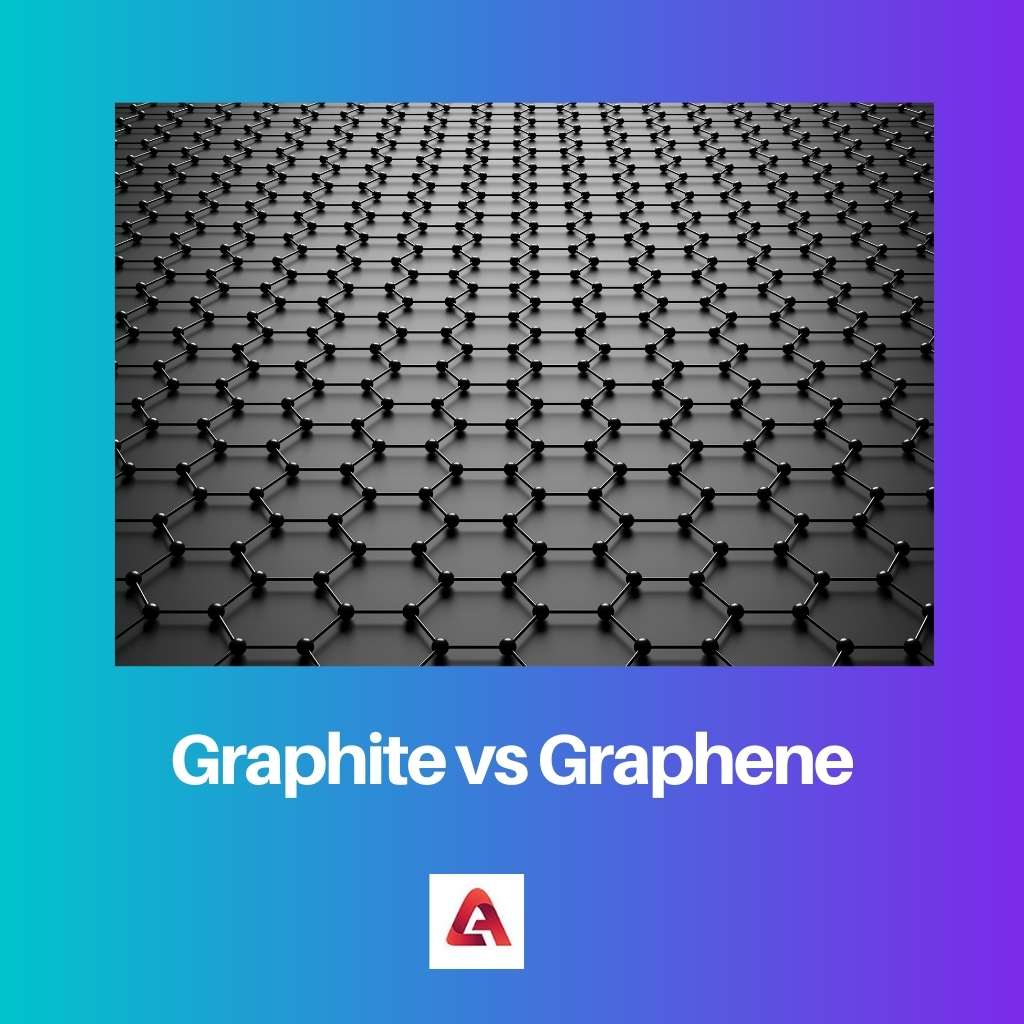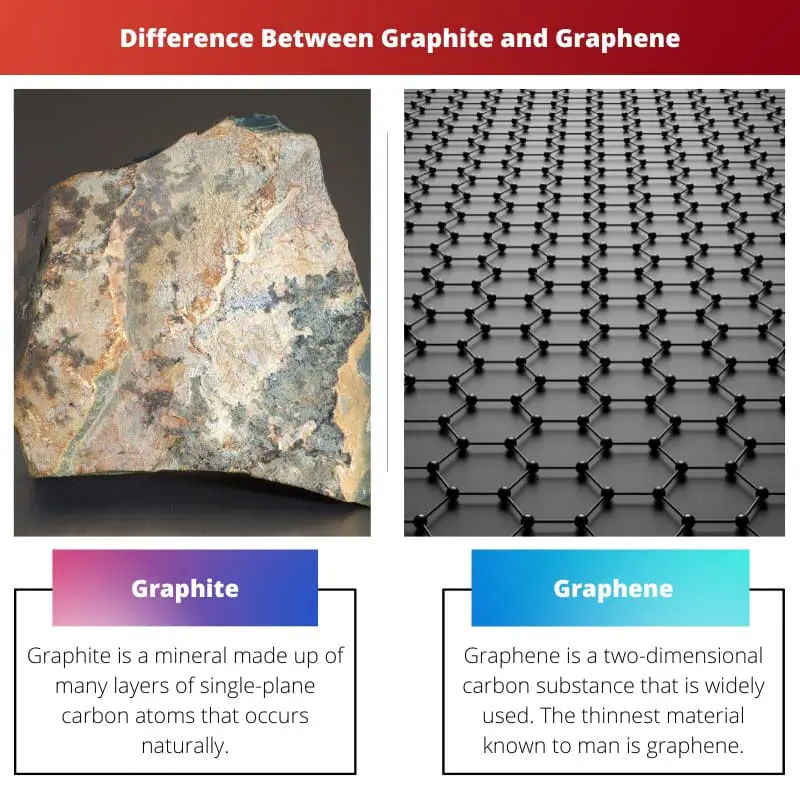Carbon atoms make up graphite and graphene, which are both carbon-based materials. Graphene is just one atomic layer of graphite – a hexagonal or honeycomb lattice of sp2 linked carbon atoms.
Graphite is a common material that is made up of multiple layers of graphene. Graphene and graphite have somewhat different structural properties and production processes.
Key Takeaways
- Graphite is a naturally occurring carbon allotrope with a crystalline structure, used in various applications like pencils and lubricants.
- Graphene is a single layer of carbon atoms arranged in a hexagonal lattice, known for its extraordinary strength and conductivity.
- Graphite is a bulk material with graphene layers, while graphene is an isolated, single layer with superior properties.
Graphite vs Graphene
Graphite is a soft, flaky material used in pencils and lubricants, for example, in addition to being a form of carbon. Graphene, that is single layer of graphite, is an excellent conductor of heat and electricity, and its properties make it a promising material for technological applications.

Graphite is a mineral made up of many layers of single-plane carbon atoms that occurs naturally. It can be found in metamorphic rocks naturally.
Metamorphism leads to the reduction of sedimentary carbon compounds, resulting in graphite formation. The chemical bonds in graphite are comparable to those found in diamonds in terms of strength.
Graphene is a two-dimensional carbon substance that is widely used. The thinnest material known to man is graphene. Carbon atoms are securely linked in a hexagonal honeycomb lattice in a monolayer of graphene.
On a tiny scale, graphene exhibits tremendous tensile strength. Because each carbon atom has a free pi-electron, graphene has outstanding electrical conductivity qualities.
Comparison Table
| Parameters of Comparison | Graphite | Graphene |
|---|---|---|
| Thickness | It is thicker as it comprises several layers of carbon. | Single-layer and thus thinner. |
| Chemical bonding | Each atom is bonded by three covalent bonds and has a free electron. | Each atom is bonded by three sigma bonds and a single pi bond which is oriented out to the plane. |
| Structure | Three-dimensional | Two-dimensional |
| Strength | Brittle | The strongest material ever. |
| Appearance | Appears to be iron-black to steel-gray in color and has luster. | Somewhat transparent. |
What is Graphite?
Graphite is a naturally occurring element that forms when organic matter in limestone deposits undergoes metamorphism.
Natural graphite is a mineral that may be found in metamorphic and igneous rocks and is used in refractories, batteries, steelmaking, expanded graphite, brake linings, foundry facings, and lubricants, among other things.
Edward G. Acheson accidentally produced graphite while conducting high-temperature carborundum studies. He discovered that the silicon in carborundum evaporates at roughly 4,150°C (7,500°F), leaving the carbon in graphitic form.
The cores of the pencils are made of graphite, which is a black, soft material with layers that may glide over each other.
The graphite is mixed with clay and water to make the pencil’s lid. The harder the pencil nib becomes as they add more clay.
Powder graphite is used to lubricate fast-moving equipment parts because of its softness. The layered structure of graphite is made up of rings of six carbon atoms organized in horizontal sheets that are widely separated.
As a result, the graphite crystallizes in the hexagonal system, as opposed to diamond, which crystallizes in the octahedral or tetrahedral systems.
Graphite has a dark grey to black color, is opaque, and is extremely soft. The word graphite comes from the Greek verb graphene, which means “to write” as it has a greasy texture and produces a black imprint.

What is Graphene?
A single layer of sp2 bonded carbon atoms in a hexagonal lattice is referred to as single-layer graphene. Graphene is a million times thinner than paper, and it’s so thin that it’s just two-dimensional.
Graphene is very flexible and transparent, in addition to having significant electrical characteristics. As a result, it’s a good candidate for portable electronics.
Graphene might make smartphones and tablets far more robust, and even allow them to be folded like paper. In a graphene sheet, each carbon atom is firmly bonded to three other atoms at similar angles, resulting in a flat, honeycomb-like structure.
These strong connections give the structure tremendous resilience, similar to diamond, which is a three-dimensional carbon crystal in which every atom is bonded to four neighbors.
The hexagonal shape of graphene serves as the foundation for fullerenes, which are hollow molecular structures made composed of 60 or more carbon molecules, similar to the lovely carbon spheres known as “buckyballs.”
These structures’ nanoscale mesh is so flexible that these can be folded into hollow cylinders, making them suitable molecular containers.
Each atom in a sheet of graphene provides one free electron to the molecule, because the element carbon has four accessible electrons for bonding.
The material’s idle negative charge contributes to its extraordinary conductive and superconductive capabilities, making it ideal for sophisticated electronics.

Main Differences Between Graphite and Graphene
- The graphite sheet has a greater thickness than graphene, which is made up of honeycomb-like layers of planar carbon atoms. Graphene is the single layer formed when a graphite sheet is ripped into a single layer with only one carbon atom thickness.
- Graphite contains three covalent bonds around each carbon atom and one free electron, whereas graphene has four links, including three sigma bonds around each carbon atom and one pi bond orientated off of the plane.
- Graphite has a three-dimensional microscopic structure that is made up of layers of graphite molecules piled like pages. Graphene is a two-dimensional substance made up of a single sheet of graphite molecules with a thickness of less than one nanometer.
- Graphite is brittle whereas graphene is the most durable substance ever studied.
- Graphite has a metallic shine and is iron-black to steel-gray in hue, whereas graphene is fairly transparent.

Reference
- https://journals.aps.org/prb/abstract/10.1103/PhysRevB.74.075404
- https://onlinelibrary.wiley.com/doi/abs/10.1002/adma.200702051
